

|
 Sparkling, bottle-conditioned, pale ale with a high alcohol content, sharply flavoured with hops, customarily by the practice of 'double hopping' - of brewing with hops and adding more, dry, hops later. 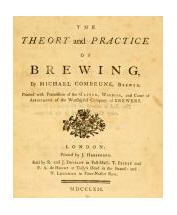 It as long been accepted that IPA came about because its higher content of the preserving alcohol and hops allowed it to endure the six-month voyage to the Indian markets being opened up in the late 18th or early 19th Centuries by the East India Company, while its light, sharp, taste made for an exceptionally refreshing drink in a hot climate. At the beginning of the 19th Century several British breweries reformulated IPA's for the home market, generally with the lower (5 to 6% ABV) of today rather than the 8 or 9% of the original, while Anglo-Indian companies such as Dyer's Lion Breweries in Shimla and Rawalpindi began an enthusiasm for English style beer throughout Asia. But, if this is true, how and why did all that happen? It as long been accepted that IPA came about because its higher content of the preserving alcohol and hops allowed it to endure the six-month voyage to the Indian markets being opened up in the late 18th or early 19th Centuries by the East India Company, while its light, sharp, taste made for an exceptionally refreshing drink in a hot climate. At the beginning of the 19th Century several British breweries reformulated IPA's for the home market, generally with the lower (5 to 6% ABV) of today rather than the 8 or 9% of the original, while Anglo-Indian companies such as Dyer's Lion Breweries in Shimla and Rawalpindi began an enthusiasm for English style beer throughout Asia. But, if this is true, how and why did all that happen? That "liquors brewed from very pale malts, preserve themselves for a long time" and "are better to allay thirst" was known at least since Micheal Combrune's 'The Theory and Practice of Brewing' of 1762 (online at: archive.org). The preservative value of hops in beer was also well known. The strength of early beers is difficult to establish. Brewers were not required to indicate alcohol content and often used an informal 'X' 'XX' 'XXX' rating, though IPA was commonly listed seperately. Beer blogger Martyn Cornell suggests that 'East India Pale Ales' had an original gravity of around 1085, which would equate to something like 8% alcohol while the first actual analysis we can find, Friedrich Accum's in 1837 gives strengths of ales between 5% and 8% Particulary famous among these London breers was George Hodgson's Bow Brewery established in 1752 near the East London docks, in an ideal position to supply ships leaving for the new lands. Hodgsons seems to have been an enthusiast for the practice of adding extra dry hops to the finished beer to further improve its keeping qualities. It is known from a report of 1835 that sailors shipwrecked from the Stirling Castle carrying 900 Barrels of Hodgson's pale ale for Australia, drank a recovered barrel and then "shared out the hops and grounds remaining at the bottom of the barrel." (online at: archive.org).  1809 Advertisement reproduced in 'Selections from Calcutta gazettes' The East India Company traded in high-value goods like silk and tea, so why send relatively low-value cargo like beer to India, a country perfectly well capable of brewing its own? Alan Pryor has ingeniously pointed out that the first advertisement for Hodgson’s beer to appear in the Calcutta Gazette in September 1793 coincided with the arrival of the Company ship Earl Cornwallis, captained by Thomas Hodgson. It is not clear if the captain was related to the brewing family, but it is known that captains of East India Company's ships were allowed to carry a substantial quantity of their own goods, free of charge, to trade as they wished. 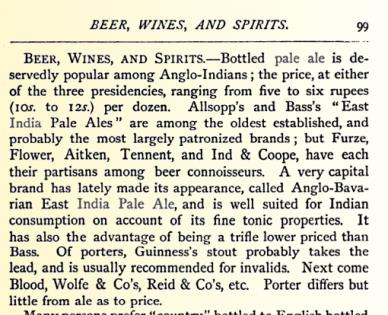 Types of India Pale Ale from 'The European in India', Delhi, 1878 Whatever the origin, it seems that the first usage of exactly the term 'India Pale Ale' occurs in advertisements, not in either England or India, but in Australia, where advertisments appeared for "Taylor's and East india pale ale" from 1829; 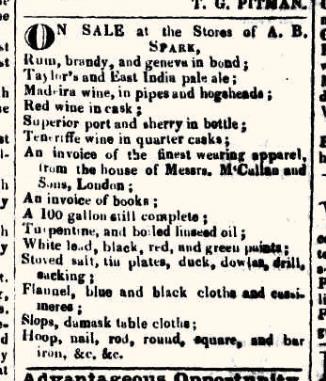 The Sydney Gazette and New South Wales Advertiser Thursday 3 September 1829 The Hodgson Brewery's use of the exact 'India Pale Ale' name is first found, not in London, but in that other great Imperial port-city, Liverpool, from 1835; 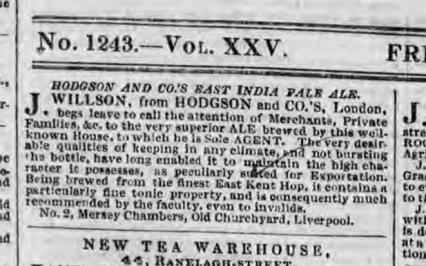 Advertisement from Hodgson's, probably the originators of IPA Liverpool Mercury - Friday 27 February 1835 Thereafter, IPA seems to have grown in favour rapidly, so that WH Roberts' 'Scottish Ale-Brewer and Practical Maltster' of 1847 could say that; "The important branch of trade which has lately so much increased, in the article of pale beer for the Indian market, and pale Indian ale for consumption at home". This may have been encouraged by the loss of Baltic Ale trade to Russia. The medical journal 'The Lancet' of September 12 1829 on 'The Suckling of Infants in India' suggested that "'Hodgson's Pale' is no bad medicine, though the Calcutta pharmacopoeia does not contain any such preparation' ... 'the first day after confinement, soup must be taken .. with two long beer glasses of pale ale.". Major Adam White's 'Considerations on the State of British India' of 1822 has; "The officers of this army are famed for indulging in copious potations of Hodgson's beer, which they generally prefer to choice Madeira, but the expense of this delightful beverage is severely felt in India. It can rarely be conveyed to the upper stations at a less expense including the original cost than half a crown a bottle." Indeed, even at home, it was something worth stealing, as in this Court Report from 1833 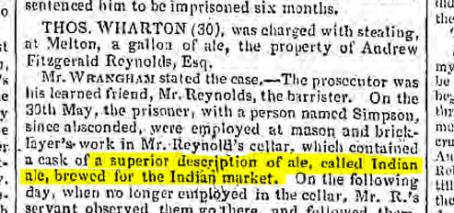 Court Report from Hull Packet - Friday 5 July 1833  The Sheffield and Rotherham Independent, 21 August 1841  'Indian Pale Ale' - paper by Alan Pryor 'Indian Pale Ale' - paper by Alan Pryor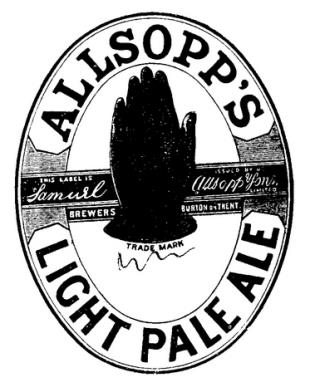 Allsops 'Light Pale Ale' Trade Mark registered at the Patent Office in 1876 specifically for "India Pale Ale" - just a few days after the first ever Registered Trade Mark which, coincidentally, was 'Bass' ale. 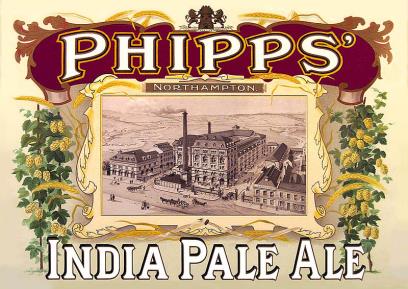  Ashby & Co.'s export India pale ale, 1876 Image: National Archives of Australia Jupiter and the Indian Ale  |
|
MORE FROM Foods of England... Cookbooks ● Diary ● Index ● Magic Menu ● Random ● Really English? ● Timeline ● Donate ● English Service ● Food Map of England ● Lost Foods ● Accompaniments ● Biscuits ● Breads ● Cakes and Scones ● Cheeses ● Classic Meals ● Curry Dishes ● Dairy ● Drinks ● Egg Dishes ● Fish ● Fruit ● Fruits & Vegetables ● Game & Offal ● Meat & Meat Dishes ● Pastries and Pies ● Pot Meals ● Poultry ● Preserves & Jams ● Puddings & Sweets ● Sauces and Spicery ● Sausages ● Scones ● Soups ● Sweets and Toffee ● About ... ● Bookshop ● Email: editor@foodsofengland.co.uk COPYRIGHT and ALL RIGHTS RESERVED: © Glyn Hughes 2022 BUILT WITH WHIMBERRY |